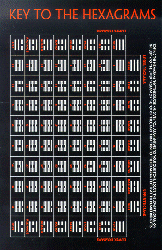

Advanced interpretation – In-depth articles for Change Circle members.Interpreting the I Ching – Introducing some simple ‘extras’ for interpretation.Ways to consult the I Ching – with step-by-step instructions.History and background – Books for insight into the historical background of the I Ching – real food for the imagination.Translations – Reviews of a great many authentic I Ching translations.Recommended books – Good books to get started with.
I CHING HEXAGRAM CHART HOW TO
Here’s how to know if you’re looking at the real thing.

At that time, plants were believed to have a direct contact with the source of creation. These were selected from plants with tall, straight stalks. In the past, 50 yarrow sticks were used to perform an I Ching divination. In this way disaster may avoided, and favorable circumstances can be exploited to the maximum. If these indications are indeed correct, it is theoretically possible to prepare for events, regardless of what they might be, in an appropriate manner. They indicate conditions in both the inner and outer worlds as they surround the diviner. So, as explained earlier, all hexagrams are inherently neutral. But what is important in a hexagram reading, like the Tarot, is not the superficial appearance of the card, or the toss of the coins, but the information that the selection conveys, the interpretation that is rendered, and how the ideas can be applied in life. After all, the Death card often bears the illustration of a skeleton. In a tarot card reading, for example, it is easy to think that drawing the Death card is a portent of misfortune. It would be a simple matter to slip into the mistake of believing that one divination was superior to another. With a superior outlook, the reading will offer clues as to how best to deal with forthcoming situations. The commentaries show us that each of the hexagrams can be interpreted in two ways, known as the superior and the inferior outlooks. It is here that the commentaries in the Ten Wings reveal a wonderful secret. They cannot be described as being either good or bad in themselves, but they do contain the seeds of either favorable or unfavorable possibilities. This in-depth analysis makes for a simple but logical system.Įach hexagram within the framework is of equal value. So the I Ching explains the meaning of the hexagram as a whole and also discusses each of the six lines as separate entities. A broken line on the bottom of the stack, for example, might indicate some kind of fundamental weakness, whereas a solid line might suggest the opposite. Each of the six lines is assigned a special meaning according to its relative position to the others in the stack.


 0 kommentar(er)
0 kommentar(er)
